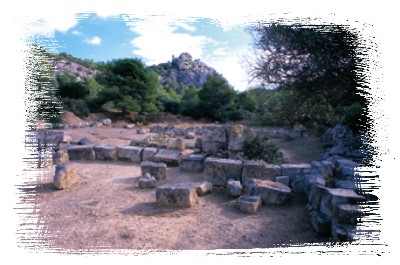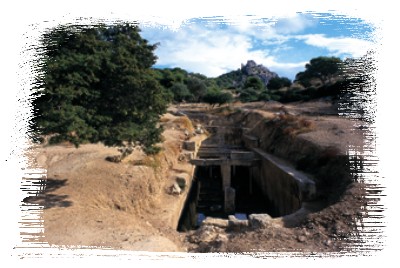

The
ruins of the famous sanctuary of Hera are to be found near the lighthouse
on Cape Malagavi, to the north-west of Loutraki and beyond the village of
Perachora amid its dense greenery.  The Heraion of
Perachora consists of
two sections, thatís why, until recently, it was believed to be two
separate sanctuaries: those of Hera Acraea ('of the cape') and Hera
Limenia ('of the harbour).
The Heraion of
Perachora consists of
two sections, thatís why, until recently, it was believed to be two
separate sanctuaries: those of Hera Acraea ('of the cape') and Hera
Limenia ('of the harbour).
Recent research, however, has led archaeologists to the conclusion that there was only one sanctuary, dedicated to Hera Acraea-Limenia.
The cult seems to have established itself in the southern part of the sanctuary (that formerly held to be the sanctuary of Hera Acraea) during the Geometric period.
Around 800 BC, the first apsidal temple of Hera was
built, but no trace of it has survived. In the sixth century BC, Š new
temple of Hera was constructed, further west. This was of a Doric order
and had Š rectangular layout measuring 10.30 meters on its short sides
and 31 meters on the long sides. To the east was an altar, also oblong and
ornamented with triglyphs. In the fourth century BC, eight Ionic columns
were constructed around the altar; these supported a shelter, which
protected the priests and the sacred flame from the strong winds that
often blow in the area. A building which has come to light to the west of
the Doric temple has been interpreted as an agora, whose functions would
have been both commercial and religious.
new
temple of Hera was constructed, further west. This was of a Doric order
and had Š rectangular layout measuring 10.30 meters on its short sides
and 31 meters on the long sides. To the east was an altar, also oblong and
ornamented with triglyphs. In the fourth century BC, eight Ionic columns
were constructed around the altar; these supported a shelter, which
protected the priests and the sacred flame from the strong winds that
often blow in the area. A building which has come to light to the west of
the Doric temple has been interpreted as an agora, whose functions would
have been both commercial and religious.
At
Š distance of 200 m. from this section of the sanctuary is the other, originally identified as the sanctuary of Hera Limenia.
This reading of
the site, which originated with
 Professor Humfry Payne, was based on the
discovery of a rectangular Archaic building which was believed to be the
temple of Hera. Professor Tomlinson, who succeeded Payne, explored the
site more systematically and interpreted the building as Š dining room
for pilgrims to the sanctuary. It would thus seem that the cult proper was
practised in the south part of the site, by the harbour, while the area
around the dining room contained the service facilities for visitors.
Professor Humfry Payne, was based on the
discovery of a rectangular Archaic building which was believed to be the
temple of Hera. Professor Tomlinson, who succeeded Payne, explored the
site more systematically and interpreted the building as Š dining room
for pilgrims to the sanctuary. It would thus seem that the cult proper was
practised in the south part of the site, by the harbour, while the area
around the dining room contained the service facilities for visitors.
Between
the two parts of the sanctuary was Š sacred pool used as Š rainwater
tank. This had become silted up as early as the fourth century BC and
during excavations some 200-glass bottles ≠connected with the sacred
rites - were found in the landfill. Not far away was a water tank with
apsidal short sides and a row of piers down the center on which the roof
would have been supported. The building is tightly waterproofed and is an
interesting example of the way in which water was collected and stored in
the fourth century BC
become silted up as early as the fourth century BC and
during excavations some 200-glass bottles ≠connected with the sacred
rites - were found in the landfill. Not far away was a water tank with
apsidal short sides and a row of piers down the center on which the roof
would have been supported. The building is tightly waterproofed and is an
interesting example of the way in which water was collected and stored in
the fourth century BC